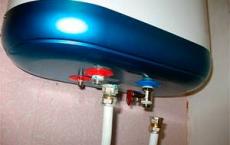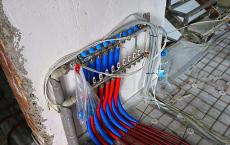How to drain water from the water heater to preserve the water supply system. Wiring diagram of the boiler to the water supply system
Comparison of ways of draining water from a storage electric water heater. An example of a convenient connection of an Electrolux boiler
If you have a storage electric water heater (EHV) installed, or you just plan to install it, then you will need to periodically drain it. For example, when you need to remove sediments in the tank, descale, replace the magnesium anode or heater and so on.
You can merge EVN in various ways. Which specific method will suit you depends on how your water heater is connected to the water supply. Therefore, if you are just planning to install a water heater, you need to think in advance how the plum will be made. If you take care of a convenient drain, then in the future you will not have to suffer every time, or even remodel the connection of the device to the water supply.
In my opinion, the most convenient way is to drain the mixer through a cold water pipe. In this article, we'll look at this and other common ways of draining and you'll be able to choose which one is the best for your system.
Common wiring diagrams for the water heater
- Scheme without any reinforcement to facilitate draining. Cranes are installed at the inlet and outlet of the water heater and a safety check valve. In some cases, there are not even cranes.
- At the entrance to the water heater, a drain valve is additionally installed, and at the outlet there is an inlet for air.
- There are cranes for draining water and air intake, while the flow from the tap for draining is sent to a cold pipeline and drained through a mixer.
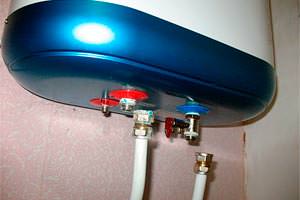
The common thing for all schemes is that for drainage it is necessary not only to allow water to leave the tank, but also to let in the tank air. If this is not done, the water will be retained in the tank by vacuum.
Air enters the tank through the outlet pipe. When the nozzle is depressurized, a small amount of water will flow out of it. This is because the hot water in the water heater is taken from above the tank through a long tube. From this tube all water should merge. Then the air from the outlet tube can flow through the tube to the upper part of the tank, and the water from the lower part will flow through the inlet pipe.
Also common to all circuits is the presence of a safety check valve. It is necessary for safety, so that the water that expands when heated, and steam does not break the storage tank. In this valve there is a discharge nozzle and a handle for test opening of the reset. A flexible tube is put on the branch pipe, the second end of which is connected to the sewage system.
The check valve function is needed to pass cold water into the tank and not to let it back. Without a non-return valve, the water could merge back into the supply water and the heating elements would burn.
Scheme without reinforcement for easier drainage
This is the simplest scheme, in which only a safety check valve and taps to disconnect from the water pipe are installed before the water heater.
The manual reset opening from the safety valve can be used for draining. To allow air to enter the tank, it is necessary to open hot water in the nearest mixer. Remains of liquid from the pipeline from the water heater to the mixer should merge and then air through this pipeline can enter the tank. But usually this does not happen, because the pipelines have a complex shape, they leave water that clogs the air passage. This method can only work if the mixer is directly under the water heater.
To ensure that the air has gone to the tank, it is necessary to disassemble one of the connections at the outlet of the water heater. The water from the tube inside the tank will pour out and air will be sucked in.
Manufacturers of water heaters in the operating instructions usually recommend exactly this scheme of connection and drainage. However, it has an obvious drawback - it is necessary to untwist the connection at the outlet of the water heater. It is very uncomfortable. Therefore, when connecting the water heater to the system, it is better to use one of the schemes described below. Another inconvenience is that the discharge of the relief valve through the thin outlet of the safety valve is rather slow. Although this is not critical.
The scheme with a separate drain cock and a tap for sucking in air
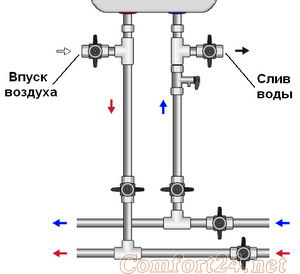
This connection allows you to drain the water heater without parsing connections. First, the supply water is blocked, and then the air intake and drain valves open.
If the water heater does not stand over the bathroom, then you need to substitute a container for a small amount of water, which will flow out of the tap to suck in air. It is desirable to put a flexible hose on the drain valve. It will allow to pour water into a bucket or sewer without sprinkling. Suitable hose from the washing machine or from the mixer. When the bucket has accumulated, the tap for sucking in air needs to be closed and the water will stop merging.
This is the fastest way to drain. The inconvenience it can cause if the water heater is installed far from the drain into the sewer. In this case, you need to tinker with a bucket and a rag to soak the puddles.
Draining through the mixer
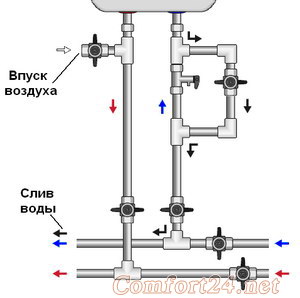
Scheme with drain through the mixer
This is a modified scheme with a separate drain cock and a tap for sucking in air. It differs in that the outlet of the drain valve is connected to the supplying cold water pipe bypassing the safety valve.
This method is slightly slower than draining directly from the tap in front of the water heater, but I think it is the most convenient. I prefer to switch the taps and go half an hour to watch TV than 10-20 minutes fiddling with a bucket and a rag.
Another convenience, that having a whole boiler of easily accessible water, you can also not worry about interruptions in water supply. There is no need to have other containers in stock.
If you need to drain the water heater faster, you can additionally open the relief vent of the safety valve.
How to drain from my home boiler
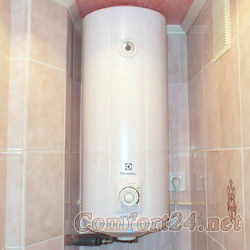
For installation used free spaces in the toilet
Installation location
The water heater is installed in the toilet on top of the toilet. Although the EVR of Electrolux 50 EWH AXIOmatic Slim is not very large, with a capacity of 50 liters, I did not put it above the bathroom to avoid occupying useful space. Details about this model are written in recall of it.
In my house, the pipes of the riser are laid in a separate niche with a door into the corridor. There are counters, taps to turn off the apartment from the water pipe and a mechanical filter. I used this niche to install the AVN connection fitting. From the water heater only two pipes go into the wall, and the safety valve and ball valves are not visible.
All switching is done in one place in the corridor. You can, for example, switch to centralized hot water supply without running between the corridor and the toilet.
Connecting the water heater to the water supply
The pipes are of metal-plastic, because I made the connection myself, but I do not have a tool for soldering plastic pipes. Brazed plastic pipes would be better, because in them the cross-section in the joints is not clamped. Due to the fact that in the fittings for the connection of metal-plastic pipes the cross-section is reduced, the boiler merges more slowly.

Connecting pipes to water heater connections
The only place where the metal-plastic is more preferable is the pipe sections near the water heater itself. Metal plastic allows you to easily bend the pipes when you need to disconnect the water heater. For this reason, often in this place put flexible hoses. I did not do it, because the hoses have a limited resource. They need to be changed every few years, otherwise there is a risk of flooding the apartment. Metal-plastic tube combines flexibility and durability. It is only necessary to install an American on the water heater sockets so that it can be easily disconnected for maintenance. Of course, this applies to any EVN, not just one like mine. The model of the device does not matter.
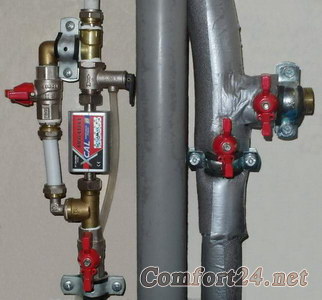
Piping of pipes and fittings in front of the water heater with the possibility of draining into the pipeline
The first on the line of the entrance to the water heater (on the left in the photo, the pipes in the photo are arranged in a mirror position on the diagram) there is a tap to turn it off from cold water. Behind him through the tee, the flow can go either to the safety valve, or through the second tap directly to the boiler. The main purpose of the second tap is the drain of the boiler, that is, the flow through it starts in the opposite direction. Through the safety valve, it can not go back, because the valve only flows in one direction.
Before the safety valve there is still a magnetic converter (often called a magnetic filter) for water softening. Whether there is any benefit from it, I can not yet unequivocally say. This is a separate topic, we will not consider it here. Instead of a magnetic converter, an ion-exchange type softener can be connected in this place of the pipe or nothing can be put. The working principle of ion-exchange softeners is described in the article on cartridges for water filters.
A discharge tube from the safety valve is inserted directly into the sewer pipe. To do this, a hole slightly drilled in the tube is drilled. The tube with interference is inserted into the hole and thanks to this it is well sealed. Smells from the drain do not come out.
At the exit from the boiler there are two cranes. Going out to the side is the one that is needed for air intake. The second is needed to cut off the boiler from the hot water pipe, when the device is disassembled for maintenance and when the system switches to centralized hot water supply.
Sequence of tap switching during draining
- the entrance of a cold water pipe to the apartment is blocked
- the hot water output from the boiler is blocked
- air sucking opens
- a line is opened bypassing the safety valve
- the entry of cold water into the boiler remains open
- cold water opens in one of the mixers and water from the boiler
All! You can go to other things and come back when the boiler is empty.
Installation of the water heater is accompanied by the need for periodic drainage of water from it. This process can be caused by various reasons: long departure, the onset of cold weather, the placement of the device in an unheated room, the need for other deposits, repair or replacement of the anode.
The boiler operates under pressure. It should be remembered that it is impossible to realize such a process as the tapping of water from a water heater by opening a hot water tap. There will be a drain of only a part of the water from under the hot water pipe. To empty the boiler, it is necessary to provide an air supply to the inside of the tank.
What ways are there
There are several methods that allow you to completely drain the water from the water heater:
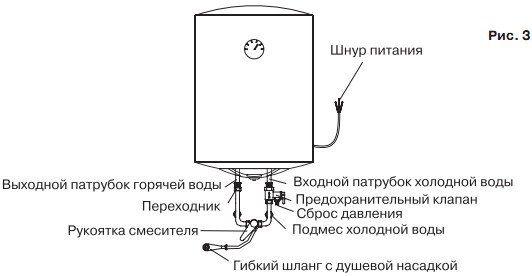
Do I need to do this and why?
In addition to cleaning the storage tank and the heating parts from the coating, the question of whether it is worth draining water from the water heater can occur when the device is used irregularly and when it breaks down.
Before draining water from the water heater, when using it "seasonally", it is necessary to familiarize yourself with the consumer's instruction, which will indicate the possible water discharge. Most manufacturers do not recommend this procedure. In addition, it must be taken into account that the lack of water in the heating tank contributes to its faster internal oxidation, which spoils the boiler materials. In order to avoid water molding, it is possible to run about 200 liters of water through a cold heater at intervals of several months. Or you can simply connect the device to the network. In addition, during long periods of inactivity, it is necessary to control the thermal indices of the room. With a temperature value of less than 5 degrees Celsius, it is possible to freeze inside the heating fluid with its expansion, which leads to damage or rupture of the tank.
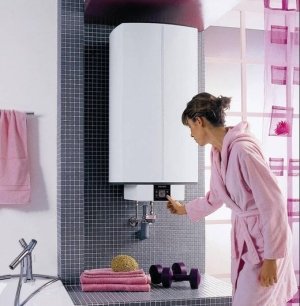
Be sure to read the instructions for using the boiler
If there are leaks or breakdowns of the boiler, an independent discharge of the liquid is not allowed. It is necessary to call the appropriate masters (especially if the device with a working guarantee), which will carry out the necessary dismantling and draining of water.
How to properly drain water from a storage tank
For carrying out of draining manipulations it is necessary to have a drain hose, pliers and a set of wrenches. The process can be divided into the following stages:
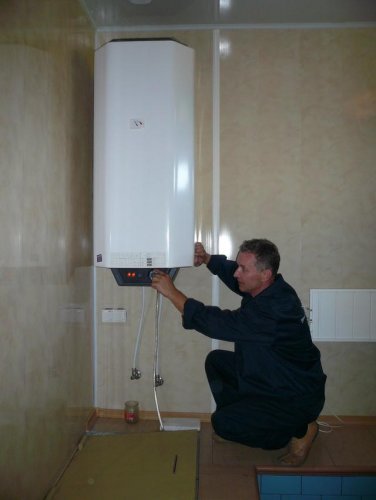
Flat water heaters are characterized by the presence of a third branch pipe, which has a stub on it. At the stage of blocking the cold flow, it is necessary to unscrew this plug. After that, the hose is connected and the nut is unscrewed from the "hot" nozzle. Thus, a slower drainage of the liquid will occur.
When implementing such a process as draining water from a water heater, it is necessary to know some aspects that affect the proper boiler operation:
- The overlap of the supply of cold liquid must be full-dimensional.
- Pressurization by opening a nearby boiler crane must be timely.
- It is necessary to unscrew the flag attachment located on the safety valve with a Phillips screwdriver. After that, the flag rises up with the pre-set prepared catchment capacity.
- With a rare discharge of water it is recommended to install tees with the corresponding cranes, which are located at the entrance and exit of the device.
Sometimes it becomes necessary to drain the water from the water heater. Do you think it's easy? Yes, it is easy, but you need to know the nuances, without which you will not be able to release the boiler.
How to drain water from the storage water heater?
Most often, the boiler tank is suspended on a wall or installed on supports. From the bottom to the water heater, connect two pipes or two flexible hoses - cold and hot. Cold water enters the water heater through the cold incoming pipe (hose). Through the hot hose - goes hot.The output of hot water occurs with the simultaneous filling of the tank with new cold water. When the cold water is turned off (in the event of an accident on the water pipe or repair of the riser in the entrance) cold water does not enter the tank. Therefore, hot water can not flow out of the boiler even when the tap is open. Now proceeding from the described features of the water heater, we will tell you how to correctly drain the water from the boiler.
To do this, it is necessary to open a cold hole (the outlet of cold water) and at the same time to ensure access of air inside the tank through the outlet of hot water. How to do this - depends on the construction of the boiler and the way it is connected (read here,). We will consider several ways to implement the plan.
Method number 1: drain the water using a safety valve
The correct installation of the water heater requires a safety relief valve. It is installed at the entrance to the tank (on a cold pipe or hose) and is designed for emergency drainage of water from the boiler. Such emergency drainage occurs spontaneously, if for any reason the pressure inside the tank exceeds the specified safety values.
In the emergency valve there is a spout for connecting the drain pipe, and there is a screw (it looks like a handle that is used to open and close the valve). Why does the valve need to be opened? To verify its operability. This is done at a frequency of once a month. The handle of the valve is opened and the water flows from the nozzle. If it flows, the valve is in working order. If it does not flow, the valve is clogged and does not perform a safety function. It must be cleaned or replaced.

Now the main thing is how to drain the water from the boiler using a valve? This is the easiest way to free the heating tank from water. It is just necessary to open the valve of the emergency device. If the valve is working - water will leak from the spout (or hoses that are attached to the spout).
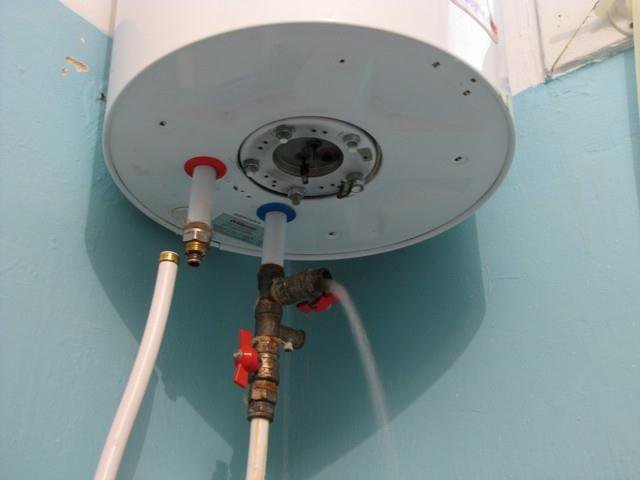
The speed of water flow through the safety valve is small. This means that a tank capacity of 80 liters will be released about 2 hours. If the valve is clogged, the flow rate of the water will be even less. In this case, the release time of the boiler can be 3 or 4 hours. To quickly drain water from the tank, you need to use the method described below.
Video on the drainage of water using an emergency valve
In the plot you can clearly see the process of draining the water.
For those who are not professional: if the water does not flow from the valve spout, it means that the device is defective (more often - clogged), and it will not be possible to drain the water in this way.
Method number 2: drain the water from the tank through the hole for cold water
This method is more complicated and will require readiness to take a wrench in order to unscrew some nuts in the boiler connection system. How to drain water from the boiler in this case?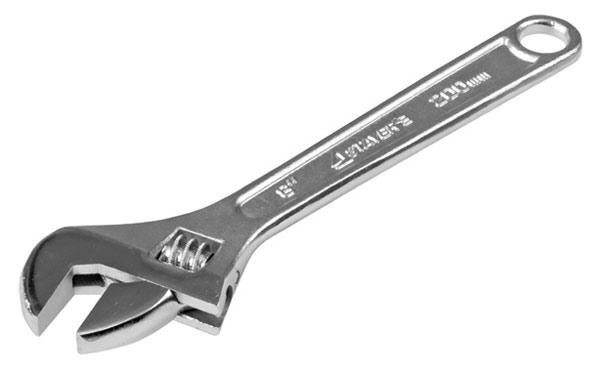
- Before the beginning of work, we block the entry of cold and hot water into the house or apartment and turn off the boiler from the electricity network. If you are a non-professional in this field of activity, you should use this rule strictly.
- Check if the hot tap is closed. If it turns out to be open, the water from the boiler will very strongly flow after unscrewing all the nuts. And we need to monitor the process and not pour a room with a few buckets of water.
- We substitute a bucket, a basin or other capacity for collecting water under the boiler.
- We unscrew the nut that connects the safety (emergency, drain, check valve) to the metal-plastic pipe or with a flexible connecting hose (flexible hoses are used when plugging a plastic water pipe).
- Disconnect the hose or pipe from the safety device.
- We unscrew the nut that connects the safety (flushing) valve to the nozzle of the heating tank. To do this, we also use the adjustable wrench.
- We remove the discharge valve (it is possible to assess its condition, the presence of clogs, if necessary, rinse with water). If the hot water tap is closed (we checked this before starting work), the water from the tank will not flow at all or it will flow out in small portions. In order for the water to flow more strongly, it is necessary that air enter the tank. How to do it?
- Open the hot water tap. In this case, air will flow through the hot pipe inside the sealed tank of the heater. The water from the cold branch pipe will flow more strongly.
- If it is necessary to regulate the flow of leaking water, use a hot tap. To reduce the flow, turn the hot tap.
- If in the boiler connection system there is a tap on the outlet of the water heater (on the hot nozzle), instead of the usual hot tap it is possible to regulate the water flow by this tap.
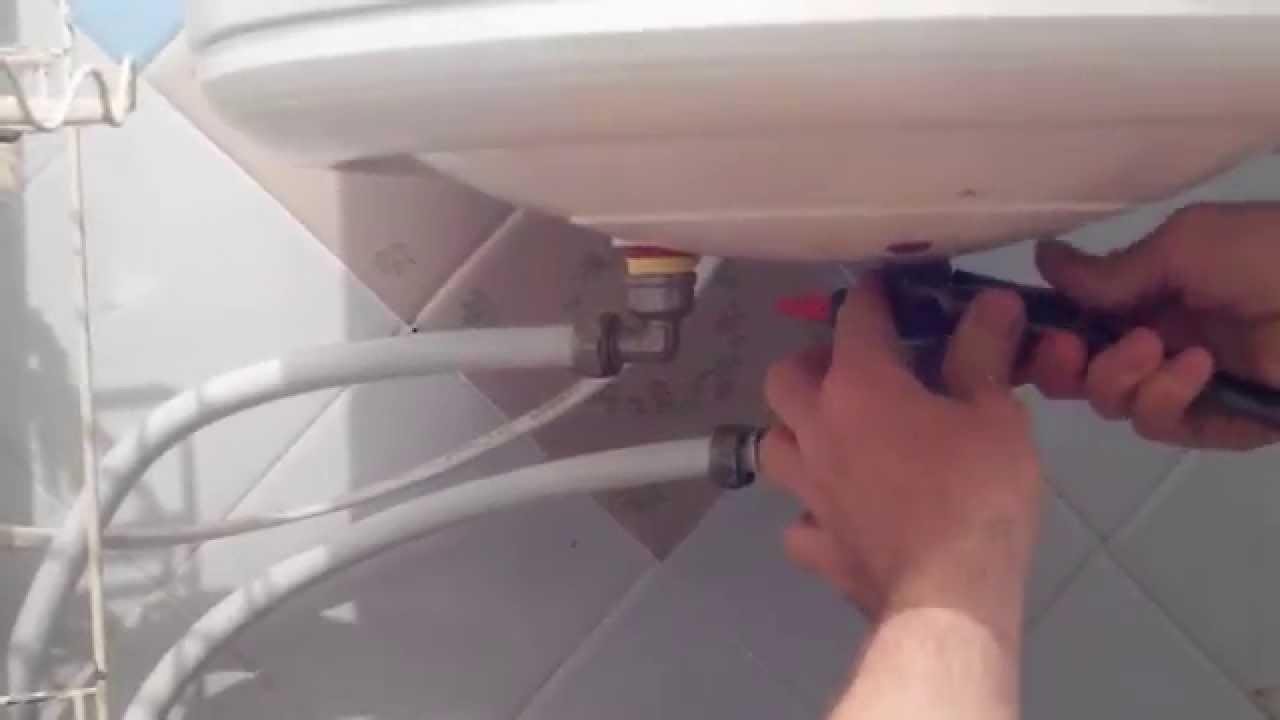
The described method allows to drain the water from the tank in a few minutes (from 3 to 5).
A video about water draining with a hole for cold water
To make it more clear what and how to do, look at the attached video. So you can perform the necessary work faster.
Method number 3: unscrew the inlet and outlet hoses
To drain the water from the water heater very quickly, you can use this method. But this method of draining water from the boiler is the most uncontrolled. They can only be used if the water heater is installed directly above the bathroom. Adjust the flow of water during draining, stop it or loosen it if necessary, it will be impossible.For draining, a cold hose and safety valve is twisted from the inlet pipe, after which the hose is removed from the hot nozzle. The water from the tank rushes down through both holes and empties the tank in a couple of minutes.
Any of the above methods does not release the boiler completely from water. In order to fully merge everything to the last drop, it is necessary to disassemble the storage tank.
Do I need to drain the water from the water heater
It depends on the conditions of its operation, design and frequency of use of the boiler. When does the drain become mandatory?- if the water heater is located in the country or in another room of periodic residence. With the onset of frost, the water inside can turn into ice and "break" the sealed storage tank;
- drainage of water is useful when there was an accident on the water pipe and there is no water in the apartment. The storage tank can provide 80-100 liters of water. It can be used to wash hands, vegetables or plums in a toilet bowl.
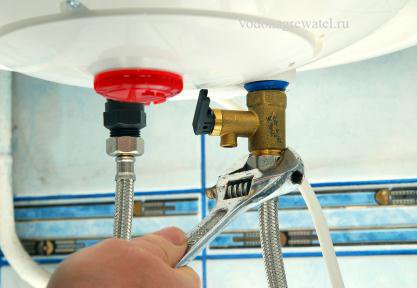
Should I drain the water from the water heater or, optionally, at the time of departure? For a boiler that is installed in a heated room, draining the water during the departure of the owners is optional. However, you must take into account the design features of your heating device:
- if the tank is made of stainless steel, it is not afraid of corrosion in the water. But it will be faster to corrode in moist air;
- for copper heaters, it is better to drain the water. Copper is more strongly destroyed in the hard water than in the humid air. And the service life of the heaters is always less than the storage tank (they have to be changed more often);
- if water enters the water heater from a centralized water supply, it contains disinfection components (chlorine). They limit the reproduction of any bacteria and the appearance of an unpleasant stale odor;
- if the water enters the tank from the well, it does not contain chlorine. Therefore, it can lead to stagnation with the formation of putrefactive unpleasant odor. Drain of such water prevents its stagnation and decay.
To get rid of the smell of stagnant water, you should rinse the boiler (turn on the tap and continue draining the tank until all the stagnant liquid comes out). Then fill the heater and turn on the maximum heat (90-95? C). This "boiling", if necessary, can be made several times.
If you decide to drain the water, drain only after the hot water has fully cooled to room temperature. The rest of the manipulations are already familiar on the basis of the article.
To drink and use hot water for other purposes, it is necessary to properly care for the water heater. But before any work is provided for the descent of water in the boiler. Depending on the correct connection of the device, the way to empty the water heater is chosen.
How to properly drain water from the water heater: the optimal time
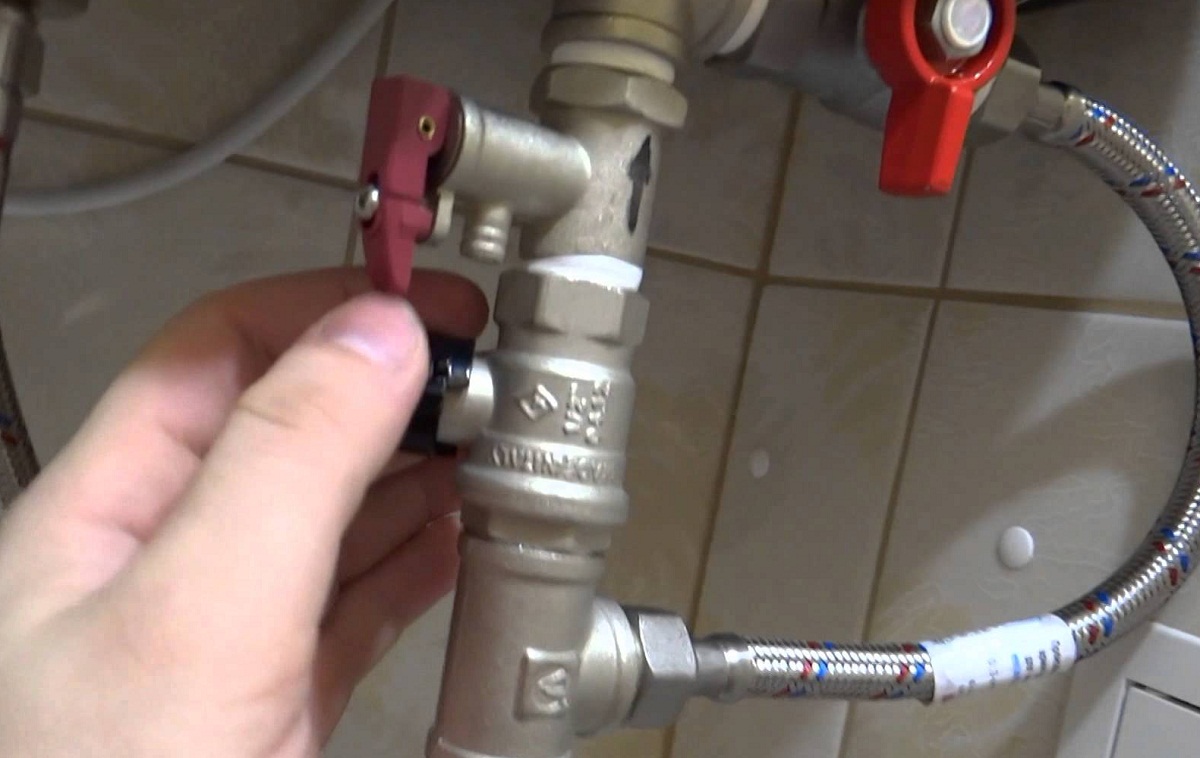
Indications for discharge of water:
- Finding a water heater for a long time in an unheated room, where the temperature drops below 5 degrees. If you leave the liquid in the boiler, it is dangerous for its operation. The tank may burst.
- When replacing the magnesium anode or TEN. Drainage is a necessary measure when repairing the device.
- When cleaning the tank. This event is important to be held at least once every 3-5 years. If you neglect this, then the boiler will be bad.
But there are a number of recommendations when it is not advised to discharge the water. So, if the device is stagnant liquid, it is better to refrain from lowering the tank. In this case, you will first need to run cold water several times through the boiler.
Descent of water is not advised to be carried out when the water heater is warranted. Otherwise, you will lose the opportunity to replace or repair the water heater for free if there is a malfunction. When they notice the interference, they will refuse any free services.
If you leave water in the boiler with a long trip, then the heater will not rust.
Do not let go of water for the desire to learn to do it right. You can simply break the device. If the boiler was left in the country house for a long time, but in the room there is a positive temperature.
Ways how to drain water from heating "titanium"
There are 3 common ways how to lower the tank of the water heater completely. They differ among themselves behind the technology itself. This method can be used for different models.

Methods of draining the water:
- Overlapping water at the entrance to the device. For this purpose, a tee is located between the branch pipe and the valve. It is enough just to open the tap.
- Use of a trigger (switch). It must be on the safety valve and must be pressed to release the water. The duration of the procedure is long enough.
- Unscrewing the check valve. In this way, water will run with a crazy head. It is better to connect the hose and send it to the sewer.
When the water is turned off, a check valve is installed immediately after the meter for cold water. But normally it should be mixed on a water heater. When the water is turned off, the tap will hold the liquid in the tank.
The device of a drain cock for a water heater
The device of the storage water heater of different manufacturers has similar characteristics. Differences can be observed only in design and advanced functionality. The basis is a large tank. Inside it there is a heating element and a temperature sensor.
Cold water is supplied to the boiler using a pipe, which is directed down the tank to a shallow depth. The nozzle ends with a head that performs the function of splashing water. Cold water is marked in blue and placed, as a rule, on the right side.
Hot liquid is supplied from above or below. Inside, the nozzle ends under the top. Hot water is marked in red and is fed from the left side.
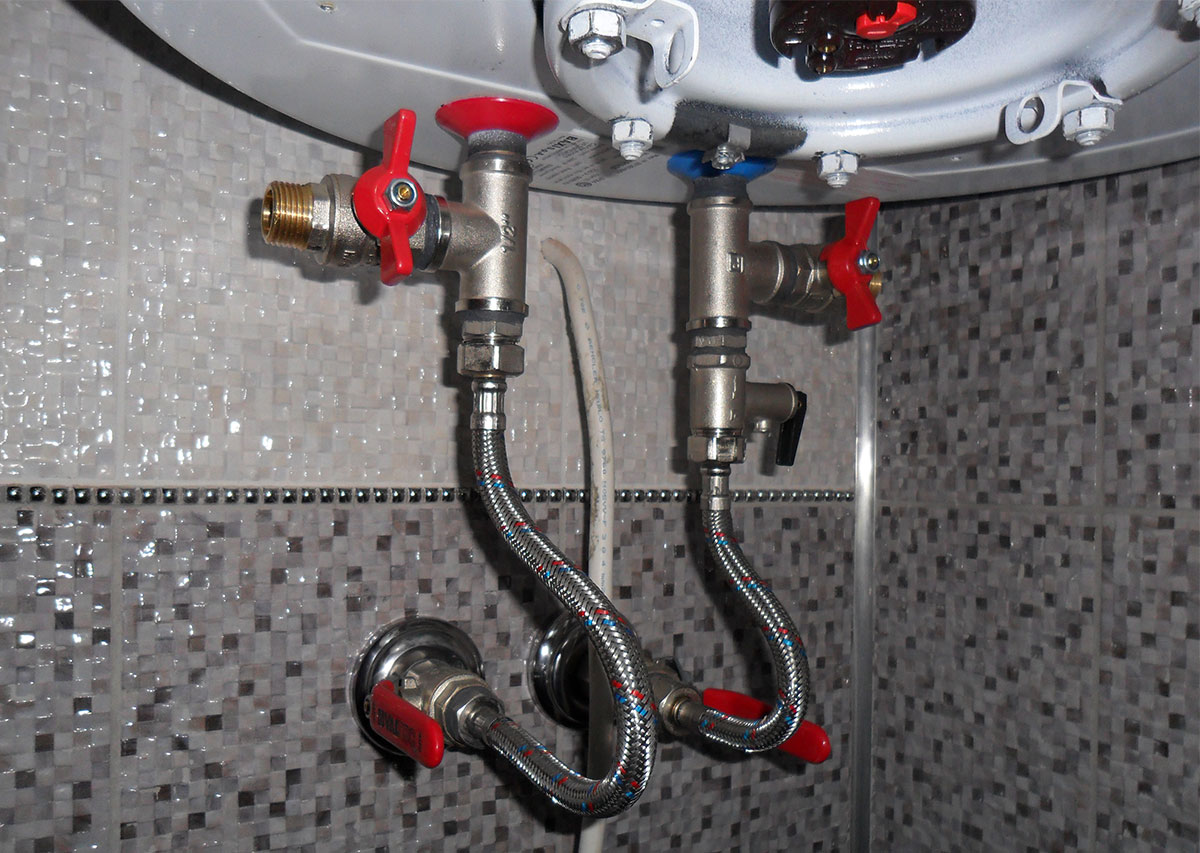
Heating device diagram:
- Temperature sensor;
- Hot water outlet;
- Thermal insulation;
- External housing;
- Magnesium anode;
- Cold water outlet.
The design guarantees uniform heating and hot water withdrawal, which rises to the top. But the liquid that enters the tank does not flow completely, it does not fall below a certain level. So the heater is protected from overheating.
To prevent water from escaping, the boiler is equipped with a check valve. But otherwise the design is completely sealed.
The check valve does not allow simply draining the water from the tank through a hot water tap. So it will be possible to merge only a small upper layer. To completely drain the water, perform a number of other operations.
Stages how to drain the water from the boiler "Termex"
The simplest version is presented with the example of the "Termex" boiler. This is not quite the right scheme, but widespread. The pipes are connected to a storage tank without additional elements. There is only a check valve on a pipe with a cold liquid with a reverse osmosis system.
Sequence of water discharge:
- Disconnect the water supply. Hot water opens, this will lower the pressure. The top layer of water merges. The crane remains open.
- Prepare the packaging for draining. Unscrew the hose, which is brought to the check valve on the tap with cold water.
- A thick wire is inserted inside the valve. This opens the valve. Water drains into the prepared container.
- In order not to stop the supply of air through the hot tap, it is necessary to blow it out or unscrew the pipe from the storage tank.
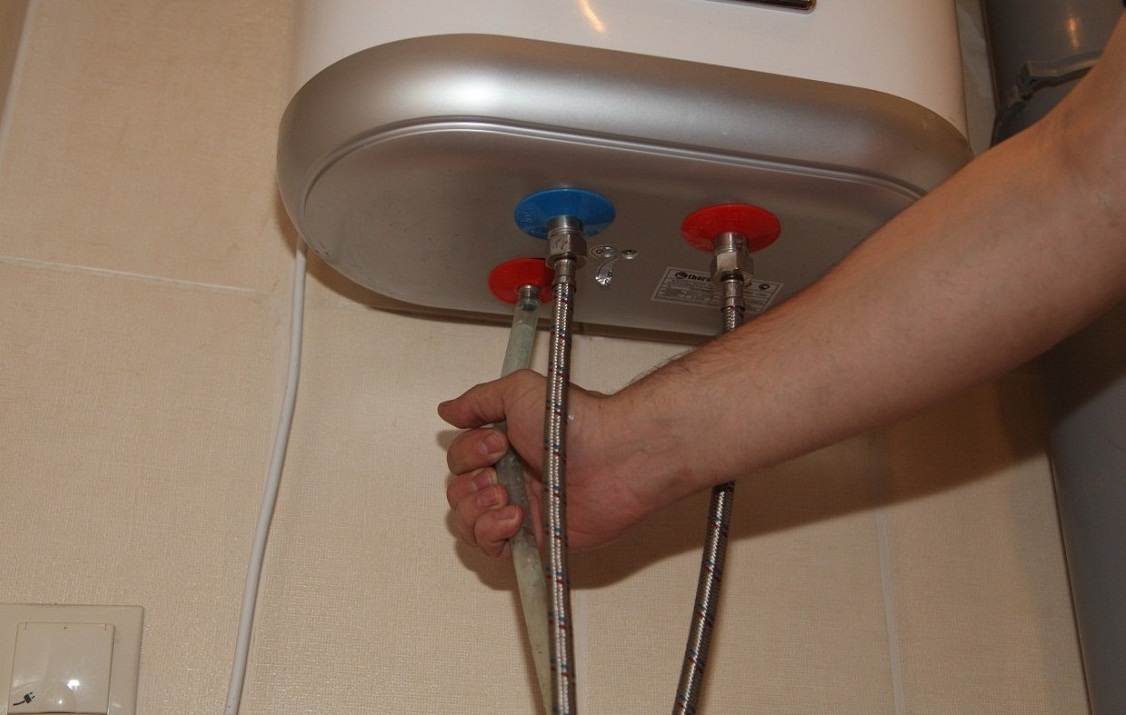
It is necessary to control the head and the rate of discharge of water into the tank. For this, a non-return valve is used. Just take out the wire. The method can be long, and because of contamination the valve will refuse to function.
This is a fairly primitive option to drain the liquid from the water-heating "titanium". It is suitable for all installations. But for work you will need special tools - a wrench and a sealing tape.
If there is a special valve on the return valve, you can not unscrew the cold water supply. In this case, you just need to unscrew the reset lever with a small flexible tube, which is thrown on the elbow. But the hot water still have to unscrew the hose.
The way how quickly to drain the water from the boiler "Ariston"
The water heater must be properly connected to the water supply. For this it is necessary to check with a special circuit for connecting all the parts. When you were sure that everything is right, you can start to drain the water from the water heater.
Correct water drain technology:
- The water in the water or the apartment is blocked.
- The boiler is disconnected from the mains. For this it is enough to remove the boiler plug from the socket.
- A tap with cold water must be closed.
- This opens the nearest tap with a hot liquid. It is required to wait until the water drains.
- The mixer remains open. This is done in order to get air into the tank.
- A special hose is connected to the drain cock. He goes to the nearest sewer.
- The drain cock opens and the water drains.
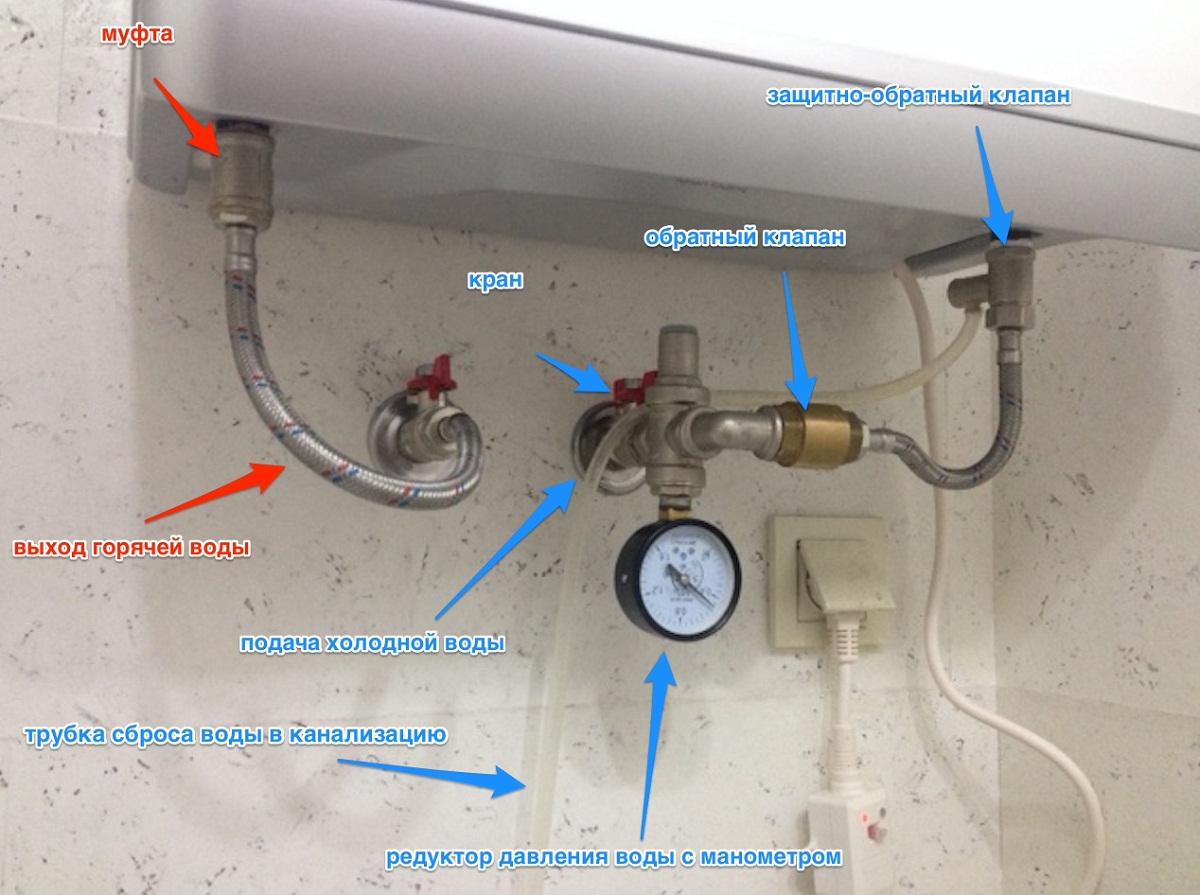
After the procedure is completed, it is necessary to check the glasses for all the liquid. That's so easy to drain the liquid from the water heater. But it is important to remember that the boiler must be connected correctly. Otherwise, you have to tinker.
Before starting work, it is necessary to wait until the water in the boiler has cooled down. The optimum temperature is 40-45 degrees. It takes about 6 hours. If there is no time to wait, then the procedure is as accurate as possible, with observance of all safety rules.
So you can quickly and easily remove the container from water. When the work is done, start the boiler maintenance, repair it. At the end of the work, the water heater is again filled with water. This should be done before connecting the boiler to the mains. To fill the boiler, connect the water supply to the house and open the taps with water. When water flows from the mixer, the tank is full.
How to remove a water heater from a wall
Removing the water heater prevents the possibility of flooding with water remnants and greatly simplifies the work with the device.
After removal, it is necessary to place the boiler on the floor with taps up. If the water heater stays on the wall, it will be necessary to dry the wiring. This is suitable for a normal hairdryer.
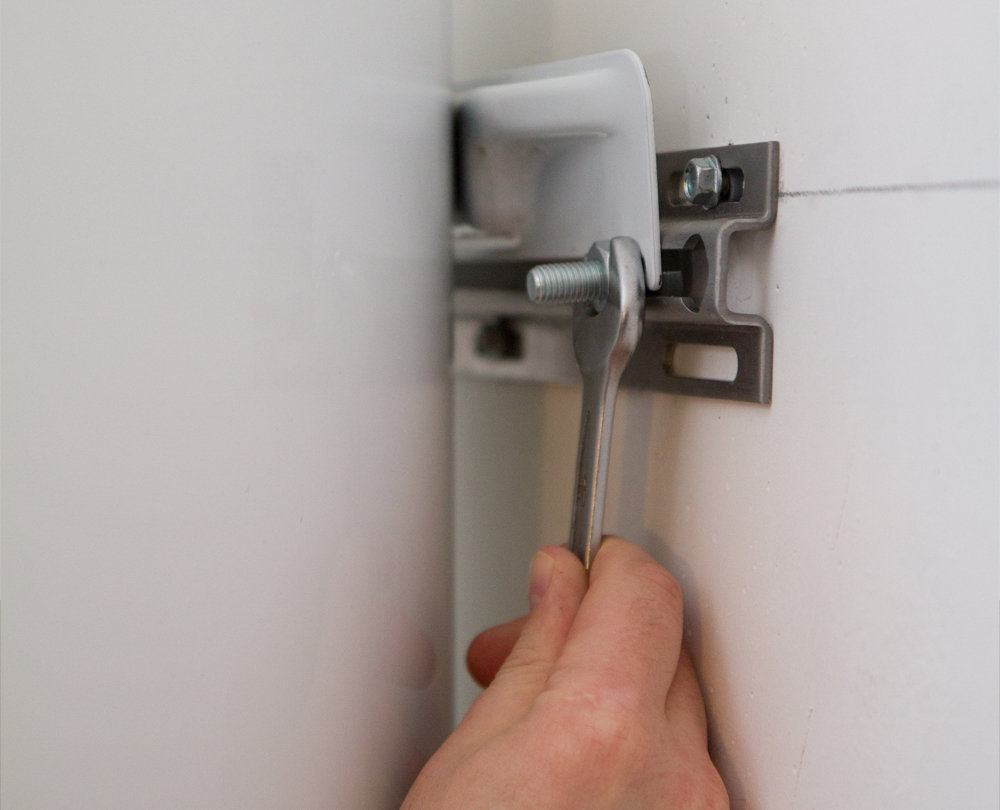
Stages of disassembling the storage device:
- The front panel is removed using two flat screwdrivers. It is enough to pull the device from both sides and pull it toward you.
- The thermostat knob is removed.
- Unscrew the 2 screws that fix the protective cover on the case. Remove the cover and get access to the electrical installation. We fix the position of all the wires. You can shoot a picture on the camera.
- Turn off the power supply by unscrewing the 3 screws on the mounting block. We get rid of the ground wire and unscrew the metal plate with the thermostat. We take out a flange with TEN and rubber sealant.
After that, you can start cleaning or repair. First, free the tank of scale, without touching the magnesium anode. Works are carried out manually. If repair is required, then make the diagnosis of the TEN. To do this, use visual assessment and validation with a special tester.
How to drain water from the boiler (video)
Pour water from different models is simple enough, while the principle of operation remains the same. The most popular companies are the boiler: Termex, Ariston, Gorenje, Electrolux. It is enough to block the water, turn off the boiler from the power supply, close the hot water valve and wait for the fluid to drain. Then open the cold water and drain the liquid from the water heater. At the same time, a hose is connected to the tap, which is sent to the sewer.
If you have a storage water heater installed at home or in the country, then periodically and sometimes suddenly, it becomes necessary to completely empty the water heater.
Despite the fact that the device manufacturers claim the exceptional simplicity of this process, in reality everything is not so easy.
Judging by the instructions, it is necessary to turn a couple of valves and the whole problem will be solved. However, in reality, it is often necessary to twist the heater.
Situations requiring this process can be the following:
- If the water heater is installed in an unheated room, where the temperature can drop below + 5 ° C, it is absolutely necessary to drain all liquid from it.
Otherwise, the water will turn into ice. And then you can not do without representatives of service organizations, and in the worst case you will have to buy a new device.
- Carrying out repair work, including the replacement of the magnesium anode.
It is impossible to carry out these processes with a tank filled with water. But keep in mind that you can do this only after the end of the warranty period.
- The need to get rid of the formed scale or sediment.
However, some users of the water heater allow a number of errors, draining the water unnecessarily.
- If you do not use the appliance for a while, but the ambient temperature does not fall below the allowable temperature.
Elements of the water heater are much more quickly corroded and destroyed if you leave it without water. In addition, it is likely that you accidentally try to turn it on in this state, then the heater may burn out or even a fire may occur.
Of course, the water that is in the tank for a long time will become musty and will get an unpleasant smell.
To get rid of this, you just need to completely refresh the entire volume of the liquid contained in it several times before using it and also warm it thoroughly.
- If the faulty unit is still under warranty, then it is in no way permissible to drain the water from it.
This can lead to a failure of the service from free maintenance.
If the device fails, call the service technician from the service company. He himself will merge the water, if necessary.
The water heater, like any other device, does not like unnecessary interference in its "internal affairs". If you are lucky, and to your house, then do not open the appliance again.
Thermex water heaters

- To drain the water from the Thermex water heater, first disconnect the device from the mains.
- Close the valve by turning off the cold water supply
- Be sure to wait for hot water to cool down or use up.
- To relieve the pressure inside the heater, proceed as follows: on the nearest mixer switch on the "hot water" and wait until it is over, and then close the tap.
- Unscrew the nuts located at the bottom of the cold water supply.
- We begin to twist this valve, pre-arranged next to a hose, which is useful for sending water to the sewer system. When you unscrew the valve, immediately connect the hose so that water does not flow to the floor from the nozzle.
- Now turn the nozzle of hot water: unscrew the nut from it. Immediately after this, water will flow through the hose, since air has started to flow into the water heater.
How to drain water from the Ariston water heater?
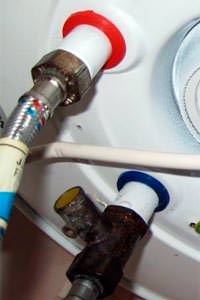
The first three points of the order of execution of actions are completely analogous to the operations described above.
- Open the valve located on the water pipe with hot water. This operation will provide air to the tank.
- Connect the hose to the pipe, through which cold water enters the water heater. Bring him into the sewer system.
You can, for example, place its end in a bath. Only it is necessary to fix it so that during the discharge it does not jump out of it.
- Open the drain cock located on this pipe and drain the water.
A small video instruction on draining water from the Ariston water heater:
Removal of residues
After you have drained all the possible water from the heater in the ways described above, do not rush to rejoice. The liquid in the device still remains. Its number will vary from a particular model, as well as the amount of sediment formed.
To empty the tank completely, it is necessary to remove the heater. Most likely, there will be a need to move the tank to the floor for a comfortable removal of the lower casing. 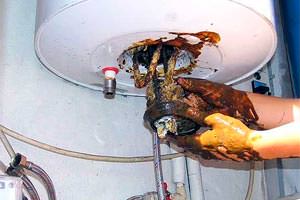
- Remove the cover. Electrical elements are carefully disconnected.
- If you lowered the device, now it's better to hang it in place. Under it, place a container for dirty liquid and various debris that will fall from the inside.
- We unscrew the TEN nut, this may require considerable effort. After you succeed, a mixture of water and scale will flow out of the hole in combination with other unpleasant formations.
In conclusion, I would like to note: there is no need, without special reasons, to drain water from the water heating device.
But if you have to do this, then clearly follow all the instructions.
Please note that when draining on the floor, water leakage may occur. Therefore, prepare rags in advance for wiping it.
If you do not have tees on the inlet and outlet of the water heater, do this, and the next time it will be much easier to drain the water.

